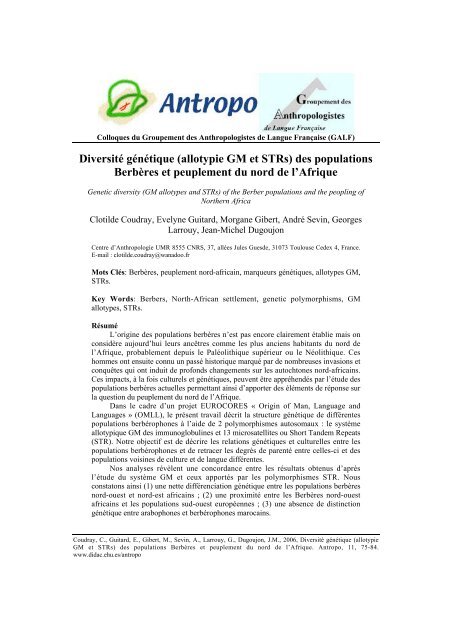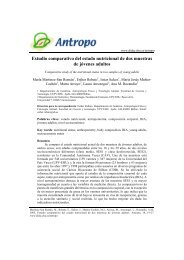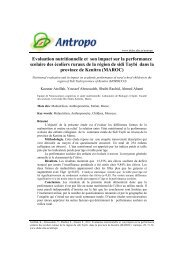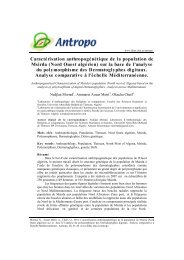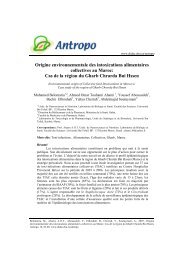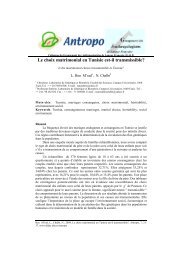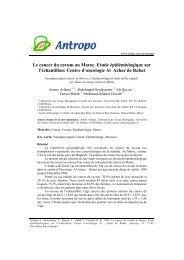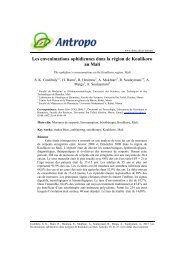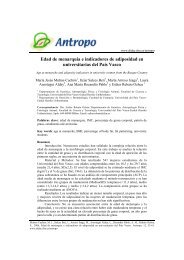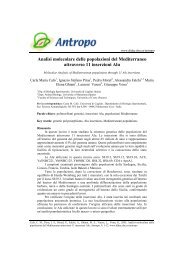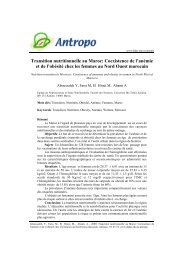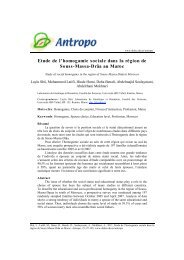des populations Berbères et peuplement du nord de l'Afrique - Antropo
des populations Berbères et peuplement du nord de l'Afrique - Antropo
des populations Berbères et peuplement du nord de l'Afrique - Antropo
- No tags were found...
Create successful ePaper yourself
Turn your PDF publications into a flip-book with our unique Google optimized e-Paper software.
Coudray <strong>et</strong> al., 2006. <strong>Antropo</strong>, 11, 75-84. www.didac.ehu.es/antropographique d’un <strong>de</strong>ndrogramme construit à partir <strong>de</strong> la variabilité <strong><strong>de</strong>s</strong> fréquences haplotypiques (oualléliques) rencontrées dans l’ensemble <strong><strong>de</strong>s</strong> <strong>populations</strong> considérées.Résultats <strong>et</strong> DiscussionNous avons tout d’abord considéré les <strong>populations</strong> <strong>nord</strong>-africaines berbérophones <strong>et</strong>arabophones (Fig. 1 <strong>et</strong> 2).L’analyse comparative <strong><strong>de</strong>s</strong> <strong>populations</strong> berbères pour le système GM révèle une n<strong>et</strong>tedifférenciation entre la population berbère <strong>de</strong> l’oasis égyptienne <strong>de</strong> Siouah <strong>et</strong> toutes les autres<strong>populations</strong> berbérophones ou arabophones <strong>du</strong> Nord-Ouest <strong>de</strong> l’Afrique (Fig. 1). C<strong>et</strong>te distinctionentre Siouah <strong>et</strong> les autres <strong>populations</strong> berbères tra<strong>du</strong>it la différenciation entre les haplotypes GMfréquemment rencontrés dans les <strong>populations</strong> sub-sahariennes (présents à plus <strong>de</strong> 50% à Siouah)<strong>et</strong> les haplotypes GM fréquemment rencontrés dans les <strong>populations</strong> ouest européennes (présentsautour <strong>de</strong> 80% dans les groupes <strong>nord</strong>-ouest africains). L’analyse comparative <strong><strong>de</strong>s</strong> <strong>populations</strong>berbères portant sur les microsatellites autosomaux révèle aussi c<strong>et</strong>te différenciation entre lesBerbères <strong>de</strong> Siouah <strong>et</strong> les autres <strong>populations</strong> <strong>du</strong> Maroc, <strong>de</strong> Tunisie <strong>et</strong> même d’Egypte (Fig. 2).Les ACP <strong><strong>de</strong>s</strong> figures 3 <strong>et</strong> 4 concernent l’ensemble <strong><strong>de</strong>s</strong> <strong>populations</strong> composant les bases <strong>de</strong>données GM <strong>et</strong> STR.Figure 1. Analyse en Composantes Principales : les Berbères <strong>et</strong> le système GM.Références: Ara, Amz, Asn, Khe <strong>et</strong> Bou : Maroc (Dugoujon <strong>et</strong> al., sous presse ; Coudray <strong>et</strong> al., sous presse) ; BKab,HKab, Mza <strong>et</strong> Kel : Algérie (Dugoujon <strong>et</strong> al., 2004 ; Dugoujon, résultats non publiés ; Lefèvre-Witier, 1982) ; Tak,Dou <strong>et</strong> Dje : Tunisie (Chaabani <strong>et</strong> al., 1984 ; Loveslati <strong>et</strong> al., 2001) ; Iss : Niger (Lefèvre-Witier, 1982) ; Sio : Egypte(Dugoujon, résultats non publiés).Figure 1. Principal Coordinate Analysis: the Berbers and the GM system.References: Ara, Amz, Asn, Khe and Bou: Morocco (Dugoujon <strong>et</strong> al., In press; Coudray <strong>et</strong> al., In press); BKab,HKab, Mza and Kel: Algeria (Dugoujon <strong>et</strong> al., 2004; Dugoujon, unpublished results; Lefèvre-Witier, 1982); Tak,Dou, Dje: Tunisia (Chaabani <strong>et</strong> al., 1984; Loveslati <strong>et</strong> al., 2001); Iss: Niger (Lefèvre-Witier, 1982); Sio: Egypt(Dugoujon, unpublished results).78
Coudray <strong>et</strong> al., 2006. <strong>Antropo</strong>, 11, 75-84. www.didac.ehu.es/antropoFigure 2. Analyse en Composantes Principales : les Berbères <strong>et</strong> les STR.Références: Ara, Asn, Bou, Mar : Maroc (Bosch <strong>et</strong> al., 2001 ; Perez-Lezaun <strong>et</strong> al., 2000 ; Coudray <strong>et</strong> al., soumis) ;Tun : Tunisie (Cherni <strong>et</strong> al., 2005 ; Brandt-Casa<strong>de</strong>vall <strong>et</strong> al., 2003) ; Egy, Sio : Egypte (Tahir <strong>et</strong> al., 2003 ; Dugoujon,résultats non publiés).Figure 2. Principal Coordinate Analysis: the Berbers and the STR polymorphisms.References: Ara, Asn, Bou, Mar: Morocco (Bosch <strong>et</strong> al., 2001; Perez-Lezaun <strong>et</strong> al., 2000; Coudray <strong>et</strong> al., submitted);Tun: Tunisia (Cherni <strong>et</strong> al., 2005; Brandt-Casa<strong>de</strong>vall <strong>et</strong> al., 2003); Egy, Sio: Egypt (Tahir <strong>et</strong> al., 2003; Dugoujon,unpublished results).L’analyse portant sur les 39 <strong>populations</strong> <strong>de</strong> la base <strong>de</strong> données GM perm<strong>et</strong> <strong>de</strong> m<strong>et</strong>tre enévi<strong>de</strong>nce 3 groupes <strong>de</strong> <strong>populations</strong> : (1) un groupe rapprochant les <strong>populations</strong> européennes <strong>et</strong>Berbères, caractérisé par <strong><strong>de</strong>s</strong> haplotypes GM communément rencontrés dans les <strong>populations</strong>européennes ; (2) un groupe constitué <strong>de</strong> toutes les <strong>populations</strong> sub-sahariennes <strong>et</strong> <strong>de</strong> lapopulation berbère <strong>de</strong> Siouah, caractérisé par <strong><strong>de</strong>s</strong> haplotypes GM fréquemment rencontrés dansles groups sub-sahariens ; (3) un <strong>de</strong>rnier groupe composé <strong><strong>de</strong>s</strong> 2 <strong>populations</strong> d’Afrique <strong>de</strong> l’Est <strong>et</strong>caractérisé par <strong><strong>de</strong>s</strong> haplotypes GM ayant une fréquence élevée dans les <strong>populations</strong> <strong>du</strong> Proche-Orient. La <strong>de</strong>rnière analyse concernant les 18 <strong>populations</strong> <strong>de</strong> la base <strong>de</strong> données STR m<strong>et</strong> aussi enévi<strong>de</strong>nce le rapprochement <strong><strong>de</strong>s</strong> <strong>populations</strong> européennes, berbérophones <strong>et</strong> arabophones, formantun groupe génétiquement différencié <strong>de</strong> celui <strong><strong>de</strong>s</strong> <strong>populations</strong> sub-sahariennes.Les résultats font donc apparaître une n<strong>et</strong>te correspondance entre les analyses <strong>de</strong> l’allotypieGM <strong>et</strong> <strong><strong>de</strong>s</strong> STRs. En eff<strong>et</strong>, on constate, qu’à propos <strong><strong>de</strong>s</strong> relations <strong>de</strong> parenté entre les groupesberbères, il existe une n<strong>et</strong>te différenciation génétique entre les <strong>populations</strong> <strong>du</strong> Nord-Ouest <strong>de</strong>l’Afrique <strong>et</strong> les Berbères d’Egypte. Ces <strong>de</strong>rniers, situés dans la partie la plus orientale <strong>de</strong> l’aire <strong>de</strong>répartition <strong><strong>de</strong>s</strong> Berbères, auraient-ils une histoire génétique différente <strong>de</strong> celle <strong><strong>de</strong>s</strong> groupes <strong>nord</strong>ouestafricains ? Les découvertes archéologiques attestent l’occupation <strong>de</strong> l’oasis <strong>de</strong> Siouah auPaléolithique supérieur autour <strong>de</strong> 6700 - 8800 ans av J.-C. (Hassan, 1978 ; Fakhry, 1973) avecune in<strong>du</strong>strie lithique particulière dite « libyco-capsienne ». Celle-ci se distingue n<strong>et</strong>tement <strong><strong>de</strong>s</strong>in<strong>du</strong>stries lithiques contemporaines présentes au Maghreb <strong>et</strong> tendrait plutôt à se rapprocher <strong>de</strong> laculture Natoufienne <strong>du</strong> Proche-Orient. D’un point <strong>de</strong> vue linguistique, le Siwi est bien un dialecteberbère ayant une proche parenté avec les parlers berbères Libyens. D’un point <strong>de</strong> vue génétique,différentes analyses : système GM, chromosome Y, ADN mitochondrial (Dugoujon, résultats nonpubliés) s’accor<strong>de</strong>nt sur le fait que la population berbère <strong>de</strong> Siouah a une structure génétiqueparticulière avec un fort pourcentage <strong>de</strong> marqueurs « sub-sahariens ». Elles m<strong>et</strong>tent aussi enévi<strong>de</strong>nce une étroite relation entre Siouah <strong>et</strong> l’Afrique <strong>de</strong> l’Est (Dugoujon, résultats non publiés).Deux hypothèses sont actuellement émises sur l’origine <strong>du</strong> <strong>peuplement</strong> <strong>de</strong> Siouah : soit lespremiers Berbères seraient venus <strong>de</strong> l’Est avec la migration <strong><strong>de</strong>s</strong> Proto-Méditerranéens <strong>de</strong>puis79
Coudray <strong>et</strong> al., 2006. <strong>Antropo</strong>, 11, 75-84. www.didac.ehu.es/antropo1989; Ferembach, 1985). Elle pourrait aussi avoir eu lieu au cours <strong>de</strong> la diffusion Néolithique<strong>de</strong>puis le Proche-Orient, il y a 10 000 ans av. J.-C. (Ammerman <strong>et</strong> Cavalli-Sforza, 1984).Au Maroc, on constate qu’il n’y a pas <strong>de</strong> distinction génétique entre les <strong>populations</strong>berbérophones <strong>et</strong> arabophones. Ceci laisserait alors supposer que la conquête arabe a été, sur les<strong>populations</strong> marocaines, un phénomène principalement culturel avec l’Islamisation <strong>et</strong>l’Arabisation <strong>de</strong> certains groupes. Quand est-il alors <strong>de</strong> l’impact génétique ? En fait, n’ayant pas àce jour les outils pour mesurer l’impact génétique <strong><strong>de</strong>s</strong> migrants Arabes sur les <strong>populations</strong> <strong>nord</strong>africaines,on pourrait penser que c<strong>et</strong>te similarité génétique entre Arabes <strong>et</strong> Berbères était déjàprésente avant la conquête Arabe. On peut aussi imaginer qu’elle résulte, pour partie, d’unehomogénéisation <strong>du</strong> pool génique par échanges réciproques entre les diverses <strong>populations</strong>.Finalement, toutes ces observations semblent en accord sur le fait que les Berbères actuels portentles traces d’un <strong>peuplement</strong> <strong>nord</strong>-africain ancien qui a <strong>du</strong> affronter <strong>et</strong> subir les différentsévènements historiques, mais qui a su préserver dans les générations suivantes ses originalitésculturelles (notamment ses coutumes <strong>et</strong> la langue).Figure 4. Analyse en Composantes Principales: les Berbères <strong>et</strong> la base <strong>de</strong> données STR.Références pour les <strong>populations</strong> <strong>nord</strong>-africaines : Ara, Asn, Bou, Mar : Maroc (Bosch <strong>et</strong> al., 2001 ; Perez-Lezaun <strong>et</strong>al., 2000 ; Coudray <strong>et</strong> al., soumis) ; Tun, Kes, Zri : Tunisie (Cherni <strong>et</strong> al., 2005 ; Brandt-Casa<strong>de</strong>vall <strong>et</strong> al., 2003) ;Ada, Cpt, Egy, Siw : Egypte (Tahir <strong>et</strong> al., 2003 ; Dugoujon, résultats non publiés).Références pour les <strong>populations</strong> sub-Sahariennes : Guin : Guinée Bissau (Goncalves <strong>et</strong> al., 2002) ;Hut, Tut : Rouanda (Regueiro <strong>et</strong> al., 2004 ; Tofanelli <strong>et</strong> al., 2003) ;Ang : Angola (Beleza <strong>et</strong> al., 2004) ; Moz : Mozambique (Alves <strong>et</strong> al., 2004).Références pour les <strong>populations</strong> sud-ouest européennes: Esp : Espagne <strong>et</strong> Por : Portugal (Perez-Lezaun <strong>et</strong> al., 2000).Figure 4. Principal Coordinate Analysis: the Berbers and the STR database.References for North-African <strong>populations</strong>: Ara, Asn, Bou, Mar: Morocco (Bosch <strong>et</strong> al., 2001; Perez-Lezaun <strong>et</strong> al.,2000; Coudray <strong>et</strong> al., submitted); Tun, Kes, Zri: Tunisia (Cherni <strong>et</strong> al., 2005; Brandt-Casa<strong>de</strong>vall <strong>et</strong> al., 2003); Ada,Cpt, Egy, Siw: Egypt (Tahir <strong>et</strong> al., 2003; Dugoujon, unpublished results).References for sub-Saharan <strong>populations</strong>: Guin: Guinea Bissau (Goncalves <strong>et</strong> al., 2002); Hut, Tut: Rwanda (Regueiro<strong>et</strong> al., 2004; Tofanelli <strong>et</strong> al., 2003); Ang: Angola (Beleza <strong>et</strong> al., 2004); Moz: Mozambique (Alves <strong>et</strong> al., 2004).References for South-West European <strong>populations</strong>: Esp: Spain and Por: Portugal (Perez-Lezaun <strong>et</strong> al., 2000).Remerciements. Nos remerciements s’adressent à toutes les personnes <strong>et</strong> infrastructures qui ont participé à la collecte<strong><strong>de</strong>s</strong> échantillons <strong>et</strong> l’acquisition <strong><strong>de</strong>s</strong> résultats. Ces recherches s’inscrivent dans le cadre <strong>du</strong> proj<strong>et</strong> EUROCORES <strong>de</strong>l’ESF (European Science Foundation), contrat no. ERAS-CT-2003-980409 <strong>et</strong> bénéficient <strong>de</strong> financements <strong>du</strong> CNRS(Centre National <strong>de</strong> la Recherche Scientifique) <strong>et</strong> <strong>du</strong> Conseil Régional <strong>de</strong> Midi-Pyrénées (Toulouse, France).81
Coudray <strong>et</strong> al., 2006. <strong>Antropo</strong>, 11, 75-84. www.didac.ehu.es/antropoBibliographieAlves, C., Gusmao, L., Damasceno, A., Soares, B., Amorim, A., 2004, Contribution for anAfrican autosomic STR database (AmpF/STR I<strong>de</strong>ntifiler and Powerplex 16 System) and areport on genotypic variations. Forensic Sci Int, 139, 201-205.Ammerman, A.J., Cavalli-Sforza, L.L., 1984, The Neolithic transition and the Gen<strong>et</strong>ics of<strong>populations</strong> in Europe (Princ<strong>et</strong>on: Princ<strong>et</strong>on University Press).Arredi, B., Poloni, E.S., Paracchini, S., Zerjal, T., Fathallah, D.M., Makrelouf, M., Pascali, V.L.,Novell<strong>et</strong>to, A., Tyler-Smith, C., 2004, A predominantly neolithic origin for Y-chromosomalDNA variation in North Africa. Am J Hum Gen<strong>et</strong>, 75, 338-45.Barbujani, G., Pilastro, A., De Domenico, S., Renfrew, C., 1994, Gen<strong>et</strong>ic variation in NorthAfrica and Eurasia: Neolithic <strong>de</strong>mic diffusion vs. Palaeolithic colonisation. Am J PhysAnthropol, 95, 137-154.Beleza, S., Alves, C., Reis, F., Amorim, A., Cariacedo, A., Gusmao, L., 2004, 17 STR data(AmpF/STR I<strong>de</strong>ntifiler and Powerplex 16 System) from Cabinda (Angola). Forensic Sci Int,141, 193-196.Ben Hamed, M., Darlu, P., 2003, Origine <strong>et</strong> expansion <strong>de</strong> l’Afro-Asiatique: méthodologie pourune approche pluridisciplinaire. Bull Mem Soc Anthropol Paris, 15, 79-99.Blanc, M., Ducos, J., 1986, Les allotypes <strong><strong>de</strong>s</strong> systèmes Gm <strong>et</strong> Km dans les provinces françaises.Dans Génétique <strong><strong>de</strong>s</strong> Populations, édité par E. Ohayon <strong>et</strong> A. Cambon-Thomsen, Paris:Colloque INSERM, 142, 207-226.Blanc, M., Sanchez-Mazas, A., Van Blyenburgh, N.H., Sevin, A., Pison, G., Langaney, A., 1990,Inter<strong>et</strong>hnic gen<strong>et</strong>ic differentiation: Gm polymorphism in eastern Senegal. Am J Hum Gen<strong>et</strong>,46, 383-392.Bosch, E., Calafell, F., Pérez-Lezaun, A., Clarimon, J., Comas, D., Mateu, E., Martinez-Arias, R.,Morera, B., Brakez, Z., Akhayat, O., Sefiani, A., Hariti, G., Cambon-Thomsen, A.,Bertranp<strong>et</strong>it, J., 2000, Gen<strong>et</strong>ic structure of north-west Africa revealed by STR analysis. EurJ Hum Gen<strong>et</strong>, 8, 360-366.Bosch, E., Clarimon, J., Perez-Lezaun, A., Calafell, F., 2001, STR data for 21 loci in northwesternAfrica. Forensic Sci Int, 116, 41-51.Brandt-Casa<strong>de</strong>vall, C., Ben Dhiab, M., Taroni, F., Gehrig, C., Dimo-Simonin, N., Zemni, M.,Mangin, P., 2002, Tunisian population data on 15 PCR-based loci. Forensic Sci Int, 126,272-274.Cavalli-Sforza, L.L., Menozzi, P., Piazza, A., 1994, The history and geography of human genes(Princ<strong>et</strong>on: Princ<strong>et</strong>on University Press).Chaabani, H., Helal, A.N., Van Loghem, E., Langaney, A., Benammar Elgaaied, A., Rivat Peran,L., Lefranc, G., 1984, Gen<strong>et</strong>ic study of Tunisian Berbers. I. Gm, Am and Kmimmunoglobulin allotypes and ABO blood groups. J Immunogen<strong>et</strong>, 11, 107-113.Cherni, L., Loueslati Yaacoubi, B., Pereira, L., Alves, C., Khodj<strong>et</strong> El Kill, H., Ben Ammar ElGaaied, A., Amorim, A., 2005, Data for 15 autosomal STR markers (Powerplex 16 System)from two Tunisian <strong>populations</strong>: Kesra (Berber) and Zriba (Arab). Forensic Sci Int, 147, 101-106.Coudray, C., Guitard, E., Lemaire, O., Cherkaoui, M., Baali, A., Hilali, K., Sevin, A., Kandil, M.,Harich, N., Melhaoui, M., Larrouy, G., Moral, P., Dugoujon, J.M., 2004, Les allotypes Gm<strong><strong>de</strong>s</strong> immunoglobulines chez les Berbères <strong>du</strong> Maroc. <strong>Antropo</strong>, 6, 63-69.Coudray, C., Guitard, E., Kandil, M., Harich, N., Melhaoui, M., Baali, A., Sevin, A., Moral, P.,Dugoujon, J.M., Study of GM immunoglobulin allotypic system in Berbers and Arabs fromMorocco. Am J Hum Biol, sous presse.Coudray, C., Guitard, E., Keyser-Tracqui, C., Melhaoui, M., Cherkaoui, M., Larrouy, G.,Dugoujon, J.M., Population gen<strong>et</strong>ic data of 15 t<strong>et</strong>rameric short tan<strong>de</strong>m repeats (STRs) inBerbers from Morocco. Soumis.Desanges, J., 1990, The proto-Berbers. Dans General history of Africa, édité par G. Mokhtar(Paris: Unesco) p 236-245.Dugoujon, J.M., Hazout, S., Loirat, F., Mourrieras, B., Crouau-Roy, B., Sanchez-Mazas, A.,2004, Gm haplotype diversity of 82 <strong>populations</strong> over the world suggests a centrifugal mo<strong>de</strong>lof human migrations. Am J Phys Anthropol, 125, 175-192.82
Coudray <strong>et</strong> al., 2006. <strong>Antropo</strong>, 11, 75-84. www.didac.ehu.es/antropoDugoujon, J.M., Lemaire, O., Guitard, E., Sevin, A., Larrouy, G., Moral, P., Sabir, B., Baali, A.,Cherkaoui, M., Diversité <strong><strong>de</strong>s</strong> allotypes <strong><strong>de</strong>s</strong> immunoglobulines (systèmes Gm <strong>et</strong> Km) d’unepopulation berbère <strong>de</strong> la vallée <strong>du</strong> Tacchedirt (Haut Atlas, Maroc). Comparaison à d’autres<strong>populations</strong> africaines <strong>et</strong> européennes <strong>et</strong> histoire <strong>du</strong> <strong>peuplement</strong> <strong>de</strong> l’Afrique <strong>du</strong> Nord. BullSoc Anthropol Paris. Sous presse.Edwards, A.W.F., 1992, The m<strong>et</strong>hod of maximum likelihood. Dans Likelihood, expan<strong>de</strong>d edition.(Baltimore and London: The Johns Hopkins University Press) p 70-102.Fadhlaoui-Zid, K., Plaza, S., Calafell, F., Ben Amor, M., Comas, D., Elgaaied, A.B., 2004,Mitochondrial DNA h<strong>et</strong>erogeneity in Tunisian Berbers. Ann Hum Gen<strong>et</strong>, 68, 222-233.Fakhry, A., 1973, Siwa Oasis (The American University in Cairo Press) 214p.Ferembach, D., 1985, On the origin of the Iberomaurusians (Upper Palaeolithic: North Africa). Anew hypothesis. J Hum Evol, 14, 393-397.Field, L.L., Dugoujon, J.M., 1989, Immunoglobulin allotyping (Gm and Km) of GAW5 families.Gen<strong>et</strong> Epi<strong>de</strong>miol, 6, 31-34.Giraldo, M.P., Vall<strong>et</strong>, M., Guitard, E., Senegas, M.T., Sevin, A., Nogues, R.M., Aluja, M.P.,Dugoujon, J.M., 1998, Gm and Km immunoglobulin allotypes in one Spanish Pyreneanpopulation: Val d’Aran. Ann Hum Biol, 25, 453-465.Giraldo, M.P., Esteban, E., Aluja, M.P., Nogues, R.M., Backes-Duro, C., Dugoujon, J.M., Moral,P., 2001, Gm and Km alleles in two Spanish Pyrenean <strong>populations</strong> (Andorra and PallarsSobirà): a review of Gm variation in the Western Mediterranean basin. Ann Hum Gen<strong>et</strong>, 65,537-548.Goncalves, R., Jesus, J., Fernan<strong><strong>de</strong>s</strong>, A.T., Brehm, A., 2002, Gen<strong>et</strong>ic profile of a multi-<strong>et</strong>hnicpopulation from Guine-Bissau (west African coast) using the new PowerPlex 16 System kit.Forensic Sci Int, 129, 78-80.Gonzalez-Pérez, E., Via, M., Esteban, E., Lopez-Alomar, A., Mazieres, S., Harich, N., Kandil,M., Dugoujon, J.M., Moral, P., 2003, Alu insertions in the Iberian Peninsula and north westAfrica - gen<strong>et</strong>ic boundaries or melting pot? Coll <strong>Antropo</strong>l, 27, 491-500.Hassan, F.A., 1978, Archeological explorations of the Siwa Oasis Region, Egypt. Curr Anthropol,19, 146-148.Hayward, R.J., 2000, Afroasiatic. Dans African Languages. An Intro<strong>du</strong>ction, édité par B. Heine <strong>et</strong>D. Nurse (Cambridge: Cambridge University Press) p 74-98.Hazout, S., Dugoujon, J.M., Loirat, F., Constans, J., 1991, Gen<strong>et</strong>ic similarity maps andimmunoglobulin allotypes of eleven <strong>populations</strong> from Pyrenees (France). Ann Hum Gen<strong>et</strong>,55, 161-174.Lefèvre-Witier, P., 1982, Structure <strong>et</strong> dynamique génétiques d’une communauté rurale <strong>du</strong> Saharacentral (I<strong>de</strong>les). Ph.D., Université Paul Sabatier, Toulouse, France.Lefranc, M.P., Lefranc, G., 1990, Molecular gen<strong>et</strong>ics of immunoglobulin allotype expression.Dans The Human IgG subclasses: molecular analysis of structure, function and regulation,édité par F. Shakib (Oxford: Pergamanon Press) p 43-78.Loveslati, B.Y., Sanchez-Mazas, A., Ennafaa, H., Marrakchi, R., Dugoujon, J.M., Lefranc, J.M.,Elgaaied, A.B., 2001, A study of Gm allotypes and immunoglobulin heavy gamma IGHGgenes in Berbers, Arabs and sub-Saharan Africans from Jerba Island, Tunisia. Eur JImmunogen<strong>et</strong>, 28, 531-538.Myles, S., Bouzekri, N., Haverfield, E., Cherkaoui, M., Dugoujon, J.M., Ward, R., 2005, Gen<strong>et</strong>icevi<strong>de</strong>nce in support of a shared Eurasian-North African dairying origin. Hum Gen<strong>et</strong>, 117,34-42.Perez-Lezaun, A., Calafell, F., Clarimon, J., Bosch, E., Mateu, E., Gusmao, L., Amorim, A.,Benchemsi, N., Bertranp<strong>et</strong>it, J., 2000, Allele frequencies of 13 short tan<strong>de</strong>m repeats inpopulation samples from the Iberian Peninsula and northern Africa. Int J Legal Med, 113,208-214.Regueiro, M., Carril, J.C., Pontes, M.L., Pinheiro, M.F., Luis, J.R., Caeiro, B., 2004, Alleledistribution of 15 PCR-based loci in the Rwanda Tutsi population by multiplexamplification and capillary electrophoresis. Forensic Sci Int, 143, 61-63.83
Coudray <strong>et</strong> al., 2006. <strong>Antropo</strong>, 11, 75-84. www.didac.ehu.es/antropoTofanelli, S., Boschi, I., Bertoneri, S., Coia, V., Taglioli, L., Franceschi, M.G., Destro-Bisol, G.,Pascali, V., Paoli, G., 2003, Variation at 16 STR loci in Rwandans (Hutu) and implicationson profile frequency estimation in Bantu-speakers. Int J Legal Med, 117, 121-126.Renfrew, C., 1991, Before Babel: speculations on the origins of linguistic diversity. CambridgeArchaeol J, 1, 3-23.Straus, L.G., 1989, Age of the mo<strong>de</strong>rn Europeans. Nature, 342, 476-477.Tahir, M.A., Herrera, R.J., el-Gohary, M., Granoff, M., Amjad, M., 2003, Allele frequencydistribution of Power Plex 1.2 and Profiler Plus short tan<strong>de</strong>m repeats (STR) loci in Egyptianpopulation. J Forensic Sci, 48, 889-890.Oudin, J., 1956, L’allotypie <strong>de</strong> certains antigènes protéiques <strong>du</strong> serum. C R Hebd Seances AcadSci, 242, 2606-2608.Van Loghem, E., Salimonu, L., Williams, A.I., Osunkoya, B.O., Boyd, A.M., De Lange, G.,Nijenhuis, L.E., 1978, Immunoglobulin allotypes in African <strong>populations</strong>. I. Gm-Amhaplotypes in a Nigerian population. J Immunogen<strong>et</strong>, 5, 143-147.Ward, R.H., 1963, Hierarchical grouping to optimise an objective function. Am Stat Assoc, 58,236-244.84


